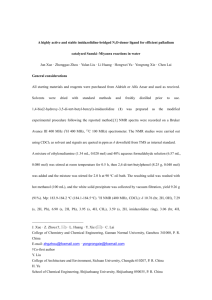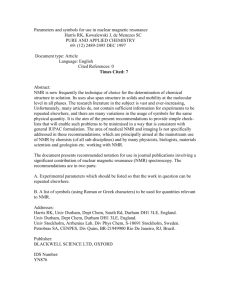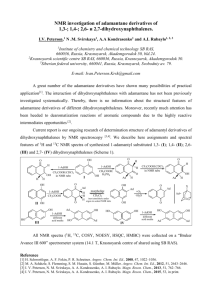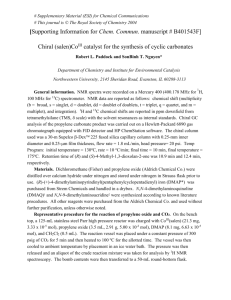full text - Ghent University Academic Bibliography
advertisement
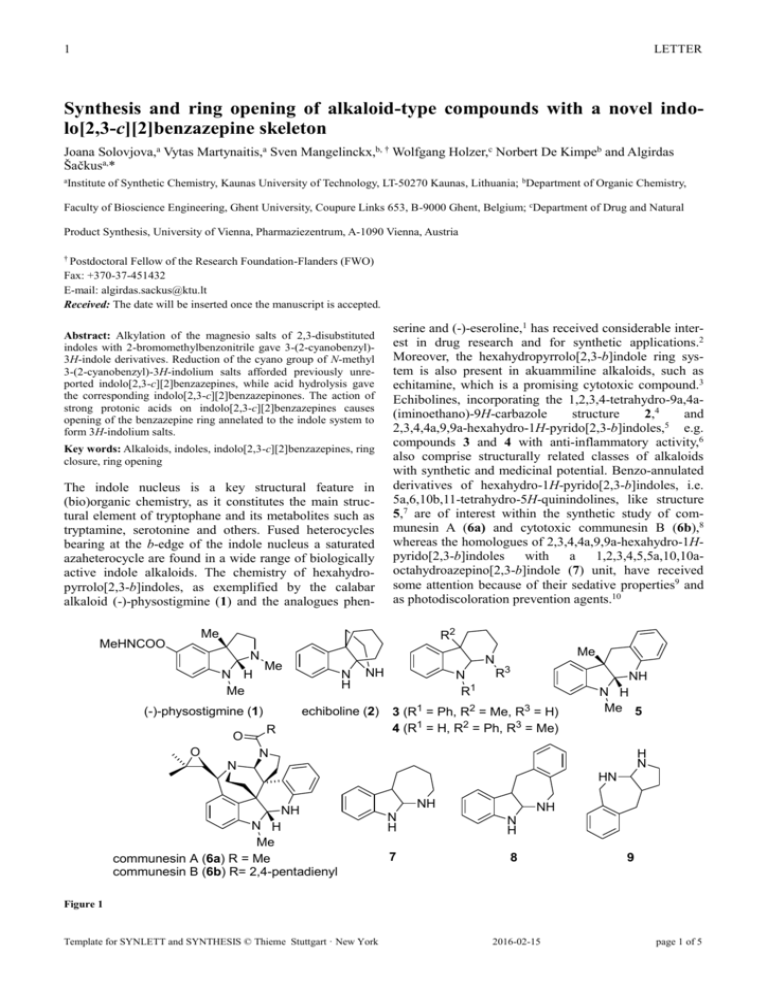
1 LETTER Synthesis and ring opening of alkaloid-type compounds with a novel indolo[2,3-c][2]benzazepine skeleton Joana Solovjova,a Vytas Martynaitis,a Sven Mangelinckx,b, † Wolfgang Holzer,c Norbert De Kimpeb and Algirdas Šačkusa,* aInstitute of Synthetic Chemistry, Kaunas University of Technology, LT-50270 Kaunas, Lithuania; bDepartment of Organic Chemistry, Faculty of Bioscience Engineering, Ghent University, Coupure Links 653, B-9000 Ghent, Belgium; cDepartment of Drug and Natural Product Synthesis, University of Vienna, Pharmaziezentrum, A-1090 Vienna, Austria † Postdoctoral Fellow of the Research Foundation-Flanders (FWO) Fax: +370-37-451432 E-mail: algirdas.sackus@ktu.lt Received: The date will be inserted once the manuscript is accepted. Abstract: Alkylation of the magnesio salts of 2,3-disubstituted indoles with 2-bromomethylbenzonitrile gave 3-(2-cyanobenzyl)3H-indole derivatives. Reduction of the cyano group of N-methyl 3-(2-cyanobenzyl)-3H-indolium salts afforded previously unreported indolo[2,3-c][2]benzazepines, while acid hydrolysis gave the corresponding indolo[2,3-c][2]benzazepinones. The action of strong protonic acids on indolo[2,3-c][2]benzazepines causes opening of the benzazepine ring annelated to the indole system to form 3H-indolium salts. Key words: Alkaloids, indoles, indolo[2,3-c][2]benzazepines, ring closure, ring opening The indole nucleus is a key structural feature in (bio)organic chemistry, as it constitutes the main structural element of tryptophane and its metabolites such as tryptamine, serotonine and others. Fused heterocycles bearing at the b-edge of the indole nucleus a saturated azaheterocycle are found in a wide range of biologically active indole alkaloids. The chemistry of hexahydropyrrolo[2,3-b]indoles, as exemplified by the calabar alkaloid (-)-physostigmine (1) and the analogues phen- serine and (-)-eseroline,1 has received considerable interest in drug research and for synthetic applications.2 Moreover, the hexahydropyrrolo[2,3-b]indole ring system is also present in akuammiline alkaloids, such as echitamine, which is a promising cytotoxic compound.3 Echibolines, incorporating the 1,2,3,4-tetrahydro-9a,4a(iminoethano)-9H-carbazole structure 2,4 and 2,3,4,4a,9,9a-hexahydro-1H-pyrido[2,3-b]indoles,5 e.g. compounds 3 and 4 with anti-inflammatory activity,6 also comprise structurally related classes of alkaloids with synthetic and medicinal potential. Benzo-annulated derivatives of hexahydro-1H-pyrido[2,3-b]indoles, i.e. 5a,6,10b,11-tetrahydro-5H-quinindolines, like structure 5,7 are of interest within the synthetic study of communesin A (6a) and cytotoxic communesin B (6b),8 whereas the homologues of 2,3,4,4a,9,9a-hexahydro-1Hpyrido[2,3-b]indoles with a 1,2,3,4,5,5a,10,10aoctahydroazepino[2,3-b]indole (7) unit, have received some attention because of their sedative properties9 and as photodiscoloration prevention agents.10 R2 Me MeHNCOO N N H Me (-)-physostigmine (1) O O N Me N H NH echiboline (2) R N R1 Me R3 3 (R1 = Ph, R2 = Me, R3 = H) 4 (R1 = H, R2 = Ph, R3 = Me) NH N H Me 5 N H N N HN NH N H Me communesin A (6a) R = Me communesin B (6b) R= 2,4-pentadienyl NH NH N H N H 7 8 9 Figure 1 Template for SYNLETT and SYNTHESIS © Thieme Stuttgart · New York 2016-02-15 page 1 of 5 2 LETTER lowed by reduction with LiAlH4 in diethyl ether under reflux, resulted in cyclization of the intermediate amine across the enamine to afford indolo[2,3c][2]benzazepines 14 (Scheme 1).13 The structure of 5,5a,12a-trimethylindolo[2,3-c][2]benzazepine 14a was established by full spectroscopic investigation and the strong NOE interactions between the 5a-CH3 and 12aCH3 groups suggested a cis relative configuration. It is necessary to point out that compounds 14a,b in solution of CDCl3 show a dynamic behaviour, which leads to more or less broadening of most signals in NMR spectra. The action of strong protonic acids on the indolo[2,3c][2]benzazepines 14 leads to opening of the azepine ring with the formation of 3H-indolium salts 15, which in turn form the initial cyclic adducts 14 under neutral conditions. The transformation of compounds 14a,b to the open form dications 15a,b in deuterated trifluoroacetic acid is indicated by the appearance of the characteristic signal of the indolium N+=C moiety in the 13C NMR spectrum at 197.9 and 199.3 ppm, respectively. The absorption maxima observed in the UV spectrum of compound 14a in ethanol are specific for indoline derivatives [λmax (log ε): 212 (2.99), 254 (2.86), 304 nm (2.51)]. The UV spectrum of compound 14a in a 100:1 (v/v) mixture of ethanol with conc. hydrochloric acid, when compared with the corresponding spectrum in pure ethanol, showed a hypsochromic displacement of the absorption bands [λmax (log ε): 208 (3.05), 232 (2.84), 272 nm (2.73)], indicating that 3H-indolium salt 15 (R = Me, X = Cl) is formed.14 Hydrolysis of the cyano group of 3H-indole 11a with concentrated sulfuric acid at 50 °C resulted in the formation of 2-(2,3-dimethyl-3H-indol-3ylmethyl)benzamide (16) in 65% yield after basic aqueous work up (Scheme 2). In the present paper, the straightforward synthesis and study of the ring-chain transformations of tetracyclic compounds with a hitherto unreported 5,5a,6,7,12,12ahexahydroindolo[2,3-c][2]benzazepine (8) system is described. These syntheses, based on a 2cyanobenzylation of indoles at C-3, followed by reductive or hydrolytic cyclization, can act as a model for the synthesis of alkaloid-like compounds since the 5,5a,6,7,12,12a-hexahydroindolo[2,3-c][2]benzazepine (8) structural element incorporates the aforementioned 1,2,3,4,5,5a,10,10a-octahydroazepino[2,3-b]indole (7) moiety as well as the 2,3,3a,4,9,10-hexahydro-1Hpyrrolo[2,3-c][2]benzazepine (9) scaffold which is also present in the structure of communesins 6.8c The starting compounds, 2,3-dimethyl-1H-indole 10a and 2,3,4,9-tetrahydro-1H-carbazole 10b prepared by Fischer indole synthesis, were alkylated at C-3 by treatment with ethylmagnesium iodide and subsequent reaction with 2-bromomethylbenzonitrile in benzene under reflux to give the corresponding 2-cyanobenzylated indoles 11a, b in 53 and 76% yield, respectively (Scheme 1).11 When the alkylation of 2,3-dimethylindole 10a was performed in a mixture of benzene and diethyl ether, the yield of compound 11a decreased (36% yield) and 12amethyl-12,12a-dihydrobenzo[4,5]cyclohepta[1,2b]indol-7(5H)-imine (12a) was formed as a minor product (17% yield).12 The 3H-indoles 11 were N-methylated in 78-91% yield upon reflux in iodomethane for 5 hours leading to 3Hindolium salts 13 which were crystallized from ethanol. These salts disclosed a typical N+=C signal at ~ 195.0 ppm in the 13C NMR spectrum (DMSO-d6). The dehydroiodination of compounds 13 with sodium carbonate to afford the corresponding enamines, fol- 1) EtMgI Et2O, , 0.5 h R R N H 10a R = Me 10b R-R = (CH2)4 R Me CN 2) 2-CN-C6H4CH2Br benzene (or benzene - Et2O) , 4 h R NH + N N H 12a (0-17%) 11a (36-53%) 11b (76%) MeI (neat) , 5 h R R R CN 1) Na2CO3, H2O R N I Me 13a (91%) 13b (78%) 2) LiAlH4 Et2O, , 5 h NH N R Me 14a (55%) 14b (67%) + HX - HX NH3 R 2X N Me 15 (X = CF3COO or Cl) Scheme 1 Template for SYNLETT and SYNTHESIS © Thieme Stuttgart · New York 2016-02-15 page 2 of 5 3 LETTER Applying the former hydrolytic conditions to tricyclic compound 11b afforded directly the indolo[2,3c][2]benzazepinone 17. The identification of the open amide 16 and the ring closed lactam 17 was based on their full spectroscopic analysis with characteristic signals in the 13C NMR spectra at 187.3 ppm (C=N) and 172.4 ppm (C=O) for the amide 16 (CDCl3) and at 79.5 ppm (diaminal C-5a) and 171.5 ppm (C=O) for the lactam 17 (DMSO-d6). In a solution of deuterated trifluoroacetic acid, the lactam 17 transforms to the 3H-indolium cation form 18, possessing a characteristic N+=C signal at 203.3 ppm in the 13C NMR spectrum (trifluoroacetic acid-d). acid also demonstrated the formation of the corresponding 3H-indolium chloride 20 (R = Me, X = Cl). 1) H2SO4 50 °C, 5 h R R CN R N Me NH 2) KOH H2O I 13a, b O N R Me 19a (53%) 19b (50%) + HX - HX R R Me N 11a 1) H2SO4 CN 50 °C, 5 h Me 2) KOH H2O CONH2 Me 16 (65%) NH 11b 20 (X = CF3COO or Cl) Scheme 3 N 1) H2SO4 CN 50 °C, 5 h N N X Me Me CONH2 O N H 17 (52%) 2) KOH H2O + HX - HX CONH2 In summary, it was found that alkylation of the magnesio salts of 2,3-disubstituted indoles with 2bromomethylbenzonitrile and subsequent reduction or hydrolysis of the introduced cyano group resulted in a straightforward synthesis of a novel type of heterocyclic systems with an indolo[2,3-c][2]benzazepine and – benzazepinone skeleton, respectively. The structure and ring-chain transformations of the latter polycyclic alkaloid-type compounds was established by full spectroscopic and elemental analysis. Acknowledgment The authors are indebted to the Research Foundation – Flanders (FWO) and Ghent University (BOF) for financial support. N H X- References and notes (1) 18 (X = CF3COO or Cl) Scheme 2 Acid hydrolysis of the substituted 3H-indolium iodides 13 followed by basic aqueous work up led to the formation of indolo[2,3-c][2]benzazepinones 19 (Scheme 3), the structure of which was fully proved by elemental and spectral analysis.15 The NOE between the 5a-CH3 and 12a-CH3 groups is indicative for the cisconfiguration of structure 19a. Spectroscopic analysis of lactams 19 in deuterated trifluoroacetic acid, showing characteristic N+=C signals at ~ 200.0 ppm, demonstrated again that treatment with protonic acids leads to cleavage of the C-N bond of the azepinone ring of compounds 19 with formation of the corresponding 3H-indolium salts 20. Typical changes in the absorption bands of the UV spectra of compound 19a in ethanol upon addition of concentrated hydrochloric Template for SYNLETT and SYNTHESIS © Thieme Stuttgart · New York (2) (3) (4) (5) (a) Brossi, A.; Pei, X. F.; Greig, N. H. Austr. J. Chem. 1996, 49, 171. (b) Greig, N. H.; Pei, X. F.; Soncrant, T. T.; Ingram, D. K.; Brossi, A. Med. Res. Rev. 1995, 15, 3. (c) Robinson, B. Heterocycles 2002, 57, 1327. (d) Huang, A.; Kodanko, J. J.; Overman, L. E. J. Am. Chem. Soc. 2004, 126, 14043. (a) Crich, D.; Banerjee, A. Acc. Chem. Res. 2007, 40, 151. (b) Takano, S.; Ogasawara, K. In The Alkaloids; Brossi, A., Ed.; Academic: San Diego, CA, 1989; Vol. 36, pp 225-251. Ramírez, A.; García-Rubio, S. Curr. Med. Chem. 2003, 10, 1891. (a) Fritz, H.; Fischer, O. Tetrahedron 1964, 20, 1737. (b) Rees, J. M. H.; Cox, B.; Tanzil, S.; Newboult, L.; Kimber, K.; Robinson, B. Adv. Biosci. 1989, 75, 93. (c) Lévy, J.; Sapi, J.; Laronze, J. Y.; Royer, D.; Toupet, L. Synlett 1992, 601. (d) Dounay, A. B.; Humphreys, P. G.; Overman, L. E.; Wrobleski, A. D. J. Am. Chem. Soc. 2008, 130, 5368. (e) Shen, L.; Zhang, M.; Wu, Y.; Qin, Y. Angew. Chem. Int. Ed. 2008, 47, 3618. (a) Sunazuka, T.; Shirahata, T.; Tsuchiya, S.; Hirose, T.; Mori, R.; Harigaya, Y.; Kuwajima, I.; Omura, S. Org. Lett. 2005, 7, 941. (b) Snider, B. B.; Wu, X. Org. Lett. 2007, 9, 4913. 2016-02-15 page 3 of 5 4 LETTER (6) (7) (8) (9) (10) (11) (12) (13) (a) Okamoto, T.; Akase, T.; Izumi, T.; Inaba, S.; Yamamoto, H. Jpn. Kokai Tokkyo Koho JP47020196; Chem. Abstr. 1972, 77, 152142. (b) Cañas-Rodriquez, A.; Leeming, P. R. J. Med. Chem. 1972, 15, 762. (c) Matthews, N.; Franklin, R. J.; Kendrick, D. A. Biochem. Pharmacol. 1995, 50, 1053. (a) May, J. A.; Zeidan, R. K.; Stoltz, B. M. Tetrahedron Lett. 2003, 44, 1203. (b) May, J. A.; Stoltz, B. Tetrahedron 2006, 62, 5262. (a) George, J. H.; Adlington, R. M. Synlett 2008, 2093. (b) Fuchs, J. R.; Funk, R. L. J. Am. Chem. Soc. 2004, 126, 5068. (c) Siengalewicz, P.; Gaich, T.; Mulzer, J. Angew. Chem. Int. Ed. 2008, 47, 8170. (a) Hester, J. B. J. Org. Chem. 1970, 35, 875. (b) Hester, J. B. US 3595874; Chem. Abstr. 1971, 75, 98552. Kaneko, Y. Jpn. Kokai Tokky Koho JP63163347; Chem. Abstr. 1989, 110, 144847. For some examples on the alkylation of indolylmagnesium halides, see: (a) Jackson, A. H.; Smith, P. J. Chem. Soc. 1968, 1667. (b) Rodriguez, J. G.; San Andres, A. J. Heterocycl. Chem. 1991, 28, 1293. (c) Gruda, I.; Leblanc, R. M. Can. J. Chem. 1976, 54, 576. Analytical and spectroscopic data for compound 12a: yellow solid, mp > 250 °C (from DMSO, with decomposition). 1H NMR (500 MHz, DMSO-d6): δ 0.78 (3H, s, CH3), 3.04 (1H, d, 2J = 14.2 Hz, 12-H), 3.09 (1H, d, J = 14.2 Hz, 12-H), 3.40 (1H, s, C=NH), 5.91 (1H, s, 6H), 6.34 (1H, br s, NH), 6.96 (1H, m, 2-H), 7.13 (2H, m, 3-H, 4-H), 7.29 (1H, d, J = 7.3 Hz, 1-H), 7.38–7.40 (3H, m, 9-H, 10-H, 11-H), 7.75 (1H, m, 8-H). 13C NMR (125 MHz, DMSO-d6): δ 22.3 (CH3), 39.7 (C-12), 51.2 (C-12a), 96.6 (C-6), 117.2 (C-4), 120.9 (C-1), 122.6 (C-2), 127.1 (C-9), 127.6 (C-3), 127.7 (C-8), 129.7 (C10), 131.8 (C-11), 133.8 (C-7a), 136.4 (C-11a), 144.5 (C-12b), 151.8 (C-7), 155.3 (C-4a), 185.3 (C-5a). IR (KBr, cm-1): N-H = 3430, N-H = 3310, N=C = 1655. MS (ES+) m/z (%): 262 ([M+2H]+, 50), 261 ([M+H]+, 100). Anal. Calcd for C18H16N2: C 83.04; H 6.19; N 10.76. Found: C 82.74; H 5.99; N 10.44. Typical Procedure for the Preparation of an Indolo[2,3-c][2]benzazepine: A solution of 3H-indolium salt 13a (0.5 g, 1.24 mmol) in ethanol (15 mL) was poured in a solution of 5% sodium carbonate (50 mL) and extracted with Et2O (3×10 mL). The combined organic layers were washed with water, dried over sodium sulfate and the solvent evaporated under reduced pressure. The residue was dissolved in dry Et2O (10 mL), LiAlH4 (94 mg, 2.48 mmol) was added and the mixture was refluxed under argon for 5 h. The reaction mixture was allowed to cool to room temperature and water (1 mL) was dropped carefully into reaction flask. A finely suspended solid was filtered off using a fritted glass filter and the solid material washed with diethyl ether (20 mL). The filtrate was washed with water, Template for SYNLETT and SYNTHESIS © Thieme Stuttgart · New York (14) (15) dried over sodium sulfate and concentrated under reduced pressure. The residue was purified by column chromatography (hexane/EtOAc, 7/1) to yield 14a (0.19 g, 55%) as a viscous oil. 1H NMR (500 MHz, CDCl3): δ 0.96 (3H, s, 5a-CH3), 1.15 (3H, s, 12a-CH3), 1.68 (1H, s, NH), 2.36 (1H d, 2J = 14.3 Hz, 12-H), 2.72 (3H, s, NCH3), 3.56 (1H, d, 2J = 15.1 Hz, 7-H), 3.68 (1H, d, 2J = 14.3 Hz, 12-H), 4.52 (1H, d, 2J = 15.1 Hz, 7-H), 6.47 (1H, d, J = 7.6 Hz, 4-H), 6.71 (1H, t, J = 7.3 Hz, 2-H), 7.00 (1H, d, J = 7.1 Hz, 1-H), 7.05 (1H, m, 8H), 7.11 (1H, t, J = 7.6 Hz, 3-H), 7.14-7.19 (3H, m, 9H, 10-H, 11-H). 13C NMR (125 MHz, CDCl3): δ 18.7 (12a-CH3), 18.9 (5a-CH3), 27.0 (NCH3), 44.7 (C-12), 45.3 (C-7), 46.2 (C-12a), 87.9 (C-5a), 106.5 (C-4), 117.5 (C-2), 121.1 (C-1), 126.3 (C-8, C-9), 126.6 (C10), 127.4 (C-3), 130.3 (C-11), 137.5 (C-12b), 138.4 (C-11a), 143.0 (C-7a), 149.1 (C-4a). 15N NMR (50.7 MHz, ref. = MeNO2): δ –333.3 (N-6), –305.4 (N-3). IR (KBr, cm-1): N-H = 3365. MS (ES+) m/z (%): 280 ([M+2H]+, 50), 279 ([M+H]+, 100). Anal. Calcd for C19H22N2: C 81.97; H 7.97; N 10.06. Found: C 81.48; H 7.60; N 10.34. Hinman, R. L.; Whipple, E. B. J. Am. Chem. Soc. 1962, 84, 2534. Typical Procedure for the Preparation of an Indolo[2,3-c][2]benzazepin-7(5H)-one: A solution of 3Hindolium salt 13a (0.5 g, 1.24 mmol) in concentrated sulfuric acid (12 mL) was heated at 50 °C for 5 h. The mixture was poured onto crushed ice, neutralized with 10% potassium hydroxide solution and extracted with Et2O (3 x 15 mL). The combined organic layers were washed with water, dried over sodium sulfate and the solvent was removed under reduced pressure. The residue was purified by column chromatography (hexane/EtOAc, 2/1) to yield 19a (0.195 g, 53%), mp 226227 °C (from ethanol). 1H NMR (500 MHz, CDCl3): δ 1.28 (3H, s, 5a-CH3), 1.45 (3H, s, 12a-CH3), 2.30 (3H, s, NCH3), 2.44 (1H, br s, 12-H), 3.29 (1H, d, 2J ~ 12.7 Hz, 12-H), 5.85 (1H, br s, 4-H), 6.54 (1H, br s, 11-H), 6.66 (1H, br t, J ~ 7.4 Hz, 2-H), 6.82 (1H, br s, NH), 6.94 (1H, br t, J ~ 7.6 Hz, 3-H), 7.03 (1H, br s, 10-H), 7.07 (1H, d, J = 7.2 Hz, 1-H), 7.16 (1H, br t, J ~ 7.3 Hz, 9-H), 7.57 (1H, br d, J ~ 7.5 Hz, 8-H). 13C NMR (125 MHz, CDCl3): δ 19.5 (5a-CH3), 21.5 (12a-CH3), 26.1 (NCH3), 47.6 (C-12), 55.1 (C-12a), 84.3 (C-5a), 104.5 (C-4), 117.1 (C-2), 121.9 (C-1), 126.5 (C-8, C9), 128.1 (C-3), 128.9 (C-11), 130.1 (C-10), 131.8 (C12b), 134.9 (C-7a), 136.3 (C-11a), 147.5 (C-4a), 172.8 (C=O). IR (KBr, cm-1): N-H = 3180, C=O = 1650. MS (ES+) m/z (%): 293 ([M+H]+, 100). Anal. Calcd for C19H20N2O: C 78.05; H 6.89; N 9.58. Found: C 78.31; H 6.91; N 9.65. 2016-02-15 page 4 of 5 5 LETTER Graphical Abstract NH NH N Me N H O N Me Short title: Synthesis of indolo[2,3-c][2]benzazepines Template for SYNLETT and SYNTHESIS © Thieme Stuttgart · New York 2016-02-15 page 5 of 5



